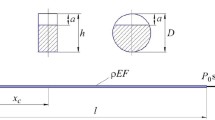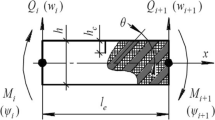Abstract
We discuss the possibility of efficient application of the harmonic analysis of strain cycles formed in an elastic rod in the process of natural or resonance vibrations to the evaluation of the degree of fatigue damage. Fatigue damage is simulated by discontinuities of the material resulting in different values of the modulus of elasticity in the processes of tension and compression. In determining the potential strain energy of a rod in the presence of a crack on the basis of linear fracture mechanics, this model enables us to deduce expressions for relative changes in the stiffness of the rod in the presence of edge and surface cracks. By using the asymptotic method of nonlinear mechanics, we find the second approximation to the solution of the differential equation of vibrations of the rod whose nonlinearity is explained by the effect of “breathing” of the discontinuity formed in the material. It is shown that the discontinuity of the material caused by fatigue damage is responsible both for changes in the natural frequency of vibrations of the rod and for significant contributions of the constant component and even harmonics to the spectrum of strain cycles in the rod. The values of the constant component and the amplitudes of even harmonics (mainly of the second one) may serve as an efficient parameter for the detection of fatigue damage to materials.
Similar content being viewed by others
Abbreviations
- a :
-
amplitude of the first harmonic of vibrations
- b :
-
width of the cross section
- d c :
-
depth of a surface crack
- E 0 :
-
the longitudinal modulus of elasticity of an intact material
- E′ :
-
longitudinal tensile modulus of elasticity of a damaged material
- E r :
-
reduced modulus of elasticity in bending
- F c :
-
area of the crack
- H I(γc):
-
dimensionless function of the relative actual length of edge cracks
- h :
-
height of the cross section
- I :
-
moment of intertia of the cross-sectional area
- j :
-
numbers of even harmonics (j=2, 4,…)
- K :
-
generalized stiffness of an intact beam
- K′ :
-
generalized stiffness of a damaged beam
- K I :
-
mode I stress intensity factor
- l andl c :
-
current and actual values of the length of an edge crack and the half-lenghh of a surface crack, respectively
- L :
-
length of the beam
- M :
-
generalized mass of the beam
- M(x) :
-
bending moment in an arbitrary cross section of the beam
- \(\overline M \)(x):
-
normalized function of the distribution of the bending moment along the length of the beam
- M 0 :
-
maximum bending moment
- M c=M(xc):
-
bending moment in a section with a crack
- Π:
-
potential strain energy
- r :
-
relative thickness of the damaged surface layer
- t :
-
thickness of the damaged surface layer
- u :
-
displacement (deflection) of the beam
- W :
-
section modulus
- X(x) :
-
natural mode of vibrations
- x :
-
coordinate of an arbitrary section
- x 0 :
-
coordinate of the section with the maximum value of the bending moment
- x c :
-
coordinate of the cracked section
- α=(E 0−E r )/E 0 :
-
(K−K′)/K,\(\bar \alpha \)=(E 0 −E′)/E 0
- β′:
-
(ω0−ω0′)/ω0,
- β″:
-
(ω0−ω0″)/ω0
- γ:
-
relative length of edge cracks (γ=l/h for a single crack and γ=2l/h for two symmetric cracks)
- Δ:
-
displacement of the neutral layer forE′εE 0
- ∈:
-
longitudinal strain
- ∈0 :
-
amplitude of the first harmonic of strain cycles in the surface layer
- λI(γ):
-
dimensionless function of the relative length of a mode I edge crack
- μ:
-
Poisson’s ratio
- σ:
-
normal stress
- σc :
-
maximum normal stress in a crack-free section with coordinatex c
- ϕ:
-
phase of the first harmonic
- ω0 :
-
angular natural (resonance) frequency of the intact beam
- ω0′ and ω0″:
-
angular natural (resonance) frequency of the beam for the cases of asymmetric and symmetric (about the neutral layer) discontinuities in the material, respectively
References
V. V. Matveev, “Efficiency of the method of spectral vibrodiagnostics for fatigue damage of structural elements. Part 1. Longitudinal vibrations. Analytic solution”,Probl. Prochn., No.6, 5–20 (1997).
G. S. Pisarenko, A. P. Yakovlev, and V. V. Matveev,Strength of Materials. Handbook [in Russian], Naukova Dumka, Kiev (1988).
Fracture. Vol. 2:Mathematical Fundamentals of the Theory of Fracture [Russian translation], Mir, Moscow (1975).
Yu. Murakami (ed.),Stress Intensity Factors. Handbook [Russian translation], Vol. 1, Mir, Moscow (1990).
Additional information
Institute for Problems of Strength, National Academy of Sciences of Ukraine, Kiev, Ukraine. Translated from Problemy Prochnosti, No. 6, pp. 9–22, November–December, 1998.
Rights and permissions
About this article
Cite this article
Matveev, V.V., Bovsunovskii, A.P. Efficiency of the method of spectral vibrodiagnostics for fatigue damage of structural elements. Part 2. Bending vibrations, analytical solution. Strength Mater 30, 564–574 (1998). https://doi.org/10.1007/BF02523160
Received:
Issue Date:
DOI: https://doi.org/10.1007/BF02523160




